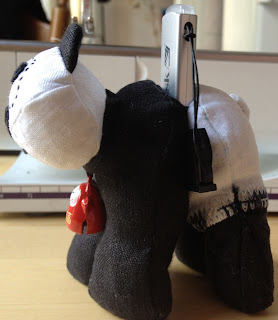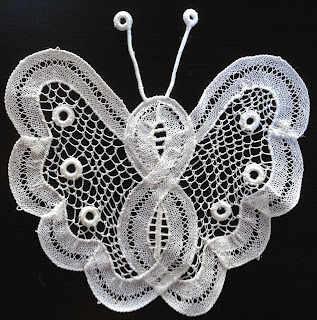As
a collector of lace bits, a couple years ago at a flea market, I purchased a
small quantity of lace tape. I was intrigued as to what to do with it. I have
always loved Battenburg lace, well at least the stuff that is not made in China,
that is. Gratifying is the sight of a well made, older Battenburg lace object
no matter what form.
On
line I found:
How to Make Battenberg and Point Lace, by Nellie Clark Brown, The Priscilla
Publishing Company, Boston Mass, Copyright 1900
http://www.cs.arizona.edu/patterns/weaving/books/bnc_lace.pdf
Madame Goubaud's Point Lace Book, Second Edition, Ward, Lock & Tyler,
Publishers http://www.cs.arizona.edu/patterns/weaving/books/gm_lace.pdf
In the first book, Nellie takes you
though the information needed to make simple Battenburg lace objects. As with
all older books, at times the description of the steps leave much to be desired.
In the second book, Madame Goubaud does the same thing in different wording.
Between the two books, enough can be learned
to begin. Modern methods need to be
employed since many of the things used in the original methods no longer exist.
Let's take a tour of what you need and where to start.
Lace
tapes/Braids
The picture shows six different types of lace tape and
braids. The top three are modern. The top one is from Martha Pullen Company and
is called 3/8" Lace Tape. The next two
below the Martha Pullen company lace tape are the most common type of lace
braids which can be purchased today.
 |
| Lace tapes |
Finally, the bottom 3 lace tapes/braids are
vintage. According to Madame Goubaud's Point Lace Book, the bottom most lace
tape is an imitation of point lace work of the fifteenth century. We learn
something new every day don't we?
Historically, lace tape/braid was made from
linen, and the thread used for the point lace was linen or cotton.
Preparation
of the pattern:
The paper pattern - leave about 1/2" to 1" extra around the edge of
the design. Cut the same size, a piece of plastic (the type you would cover a child's
schoolbook with and a piece of the Kraft paper. Baste the 3 layers together
with the Kraft paper on the bottom, the pattern as the sandwich in between and
the plastic on top.
Application
of lace tape
Here is where any knowledge in heirloom
sewing comes in handy. The drawing below illustrates how the tape is basted
down to the 3 layers basted together in the last step. This is from Nellie Clark
Brown's book , How to Make Battenberg and Point Lace, page 2.
For a butterfly I made, this is how it
looks. Use a contrasting thread, for ease of removal later, Whichever way the
design twists, baste on the outside curve. Just like in working with French
lace, (this is the heirloom sewing part) this modern lace braid contains pulling
threads. Those are carefully pulled to draw the inside curve flat.
A
nice to have supply
I do not have one, but I am looking for a ring gauge. The ring gauge is used to
aid in making the round circles of thread seen often in Battenburg lace
objects. Nellie notes in her book that we can buy "very excellent
rings". Ya, right, not in this century! I did look, unsuccessful at both
Wal-Mart and Eurodif (ok, I really did not look) Might I suggest we make them
ourselves? They are not hard to master, but the idea of making 100s of these
for someone to buy is mind numbing.
Small
Aside About Thread
The models you see in the photos use both
the DMC Cordonnet Special, 20g Nₒ 80 and Nₒ 60 threads. In the pictures, the ring on
the left is No 80 the one on the right is No 60, Note the size difference due to the thread thickness.

To make a button hole ring, the thread is
wound around the base of a fork tine 20 times. Who needs a ring gauge anyway???The
more wraps the thicker the ring is. Less than 15 wraps leaves a less than
desirable look to the ring. More than 25 makes the ring too thick. Wrap the thread
tightly at the same level at the bottom of the tine catching the start of the
thread in the wrapping process. Hold the wrapped portion in place with your
thumb as you cut the thread about 16 inches from your thumb. Thread a needle
with this thread end. Slide the thread wraps up the tine a little so that a
needle can be passed repeatedly around the roll of thread between the wound
thread and the fork tine. After 1 wrap begin to make several button hole
stitches. Push them flush with each other. Slide the thread wraps off of the
fork and continue making button whole stitches until the wrapped thread is
completely covered all the way around. Leave the additional thread on the ring.

Here is one of the rings after it is
placed in the Battenburg lace design. This picture to me is like when someone
checks the inside of your garment to see how well you finished the seams.
All of the fill stitches also known as Point Lace came from one of the two books, So here now were two of the 4 butterflies I made.. I learned a lot
Enough with the butterflies and I do not need more doilies. Then, I found this book...
Dillmont, Th. de, ed. D.M.C. Dentelle Renaissance, La. Mulhouse, Dollfus Mieg & Cie, [c.1890] 76 pgs. + plates and patterns.
http://www.antiquepatternlibrary.org/pub/PDF/DMCDentelleRen.pdf
The information about the book says "Needle laces made with manufactured tapes and braids (many no longer available) that work up quickly to stunning results."
Sounds interesting to say the least.
I download it
The book, originating from Mulhouse tells me that it will be written clearly in French, which it was. Mulhouse is located in Alsace and at one time was a huge manufacturer of everything from thread, fabrics and patterns of all sorts. You can still buy fabric made in and near Mulhouse. Beautiful, French country wovens called Kelsch. But I digress. Back to the book...
Just like my picture above, they have many lace tapes and braids that can be used. The book has lots of ideas for making yardage of lace. Wait! I have some of those laces in my stash! I had no idea where one would use them or how one would use them. well not quite true. I have a baby bonnet with a silk lining that is made using one of the top lace braids on the right side.
So, back to the book, I found this lace:
And the pattern was included in the back of the book:
And I know how to make Battenburg lace, I found my project!
I start sewing, and sewing and sewing. I get to the flower part and nothing works. I tried Floche, Sulky 30 wt, 12 wt, silk antique stuff I got at a yard sale, DMC Cordonnet Special, 20g Nₒ 80 and Nₒ 60 threads. I stop and look to see how this embroidery on netting is done. BTW. This is using all of my scraps of netting I have collected over the years. Netting is so expensive, I can't stand to throw any out.
I find a piece of a collar in my lace bit stash. If collars come in two pieces, over time one will be lost.
Here is a close up, hopefully you can see the embroidery better.
I finally decide to try what I should have started with; 6 strand DMC floss. So here is what I have. It travels well as long as the netting is in place and now that I know what I am doing it is going a lot faster.
Notice that I got
rid of the second row of lace braid at the top since of all stitches I hate doing the
spider web sort of thing. It is growing on me now that I am getting better, but
it is still not something I like doing.
The braid on the outside edge I own nothing remotely similar. In Wisconsin I found the two inspirations below. Notice the poor-man application of the trim I am missing. (yes I paid 25 cents) Interesting. I might add it later, I don't know.


I plan to make enough lace for the bottom hem of a shirt and the sleeves. I will be working on this for a while since it is a great train or car project.
So here it is:

And a close up of it on the roll
No you may not order yardage.




































